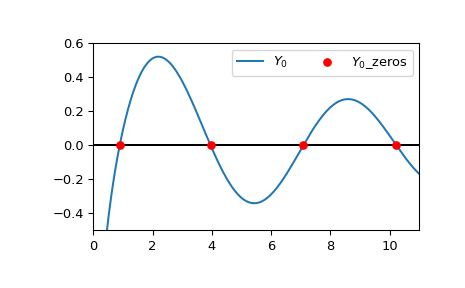scipy.special.
y0_zeros#
- scipy.special.y0_zeros(nt, complex=False)[source]#
计算贝塞尔函数 Y0(z) 的 nt 个零点,以及每个零点处的导数。
导数在每个零点 z0 处由 Y0’(z0) = -Y1(z0) 给出。
- 参数:
- ntint
要返回的零点数量
- complexbool, default False
设为 False 只返回实数零点;设为 True 只返回实部为负且虚部为正的复数零点。请注意,后者的复共轭也是函数的零点,但此例程不返回它们。
- 返回:
- z0nndarray
Y0(z) 的第 n 个零点位置
- y0pz0nndarray
第 n 个零点处导数 Y0’(z0) 的值
参考文献
[1]Zhang, Shanjie and Jin, Jianming. “Computation of Special Functions”, John Wiley and Sons, 1996, chapter 5. https://people.sc.fsu.edu/~jburkardt/f77_src/special_functions/special_functions.html
示例
计算 \(Y_0\) 的前 4 个实数根以及在这些根处的导数。
>>> import numpy as np >>> from scipy.special import y0_zeros >>> zeros, grads = y0_zeros(4) >>> with np.printoptions(precision=5): ... print(f"Roots: {zeros}") ... print(f"Gradients: {grads}") Roots: [ 0.89358+0.j 3.95768+0.j 7.08605+0.j 10.22235+0.j] Gradients: [-0.87942+0.j 0.40254+0.j -0.3001 +0.j 0.2497 +0.j]
绘制 \(Y_0\) 的实部以及前四个计算出的根。
>>> import matplotlib.pyplot as plt >>> from scipy.special import y0 >>> xmin = 0 >>> xmax = 11 >>> x = np.linspace(xmin, xmax, 500) >>> fig, ax = plt.subplots() >>> ax.hlines(0, xmin, xmax, color='k') >>> ax.plot(x, y0(x), label=r'$Y_0$') >>> zeros, grads = y0_zeros(4) >>> ax.scatter(zeros.real, np.zeros((4, )), s=30, c='r', ... label=r'$Y_0$_zeros', zorder=5) >>> ax.set_ylim(-0.5, 0.6) >>> ax.set_xlim(xmin, xmax) >>> plt.legend(ncol=2) >>> plt.show()

通过设置
complex=True计算 \(Y_0\) 的前 4 个复数根以及在这些根处的导数。>>> y0_zeros(4, True) (array([ -2.40301663+0.53988231j, -5.5198767 +0.54718001j, -8.6536724 +0.54841207j, -11.79151203+0.54881912j]), array([ 0.10074769-0.88196771j, -0.02924642+0.5871695j , 0.01490806-0.46945875j, -0.00937368+0.40230454j]))